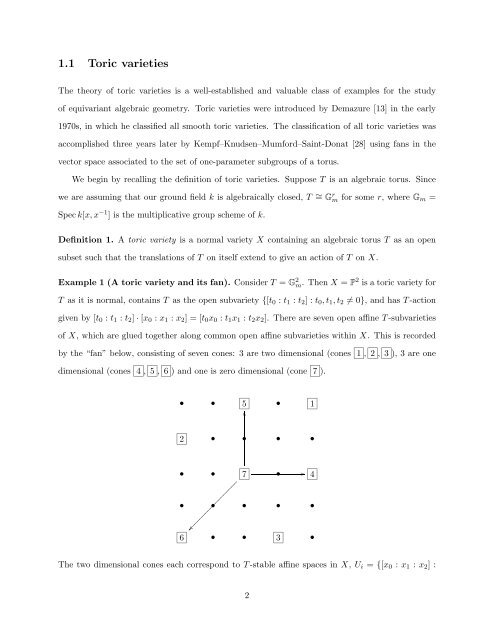Equivariant Embeddings of Algebraic Groups
Equivariant Embeddings of Algebraic Groups
Equivariant Embeddings of Algebraic Groups
You also want an ePaper? Increase the reach of your titles
YUMPU automatically turns print PDFs into web optimized ePapers that Google loves.
1.1 Toric varieties<br />
The theory <strong>of</strong> toric varieties is a well-established and valuable class <strong>of</strong> examples for the study<br />
<strong>of</strong> equivariant algebraic geometry. Toric varieties were introduced by Demazure [13] in the early<br />
1970s, in which he classified all smooth toric varieties. The classification <strong>of</strong> all toric varieties was<br />
accomplished three years later by Kempf–Knudsen–Mumford–Saint-Donat [28] using fans in the<br />
vector space associated to the set <strong>of</strong> one-parameter subgroups <strong>of</strong> a torus.<br />
We begin by recalling the definition <strong>of</strong> toric varieties. Suppose T is an algebraic torus. Since<br />
we are assuming that our ground field k is algebraically closed, T ∼ = G r m for some r, where G m =<br />
Spec k[x, x −1 ] is the multiplicative group scheme <strong>of</strong> k.<br />
Definition 1. A toric variety is a normal variety X containing an algebraic torus T as an open<br />
subset such that the translations <strong>of</strong> T on itself extend to give an action <strong>of</strong> T on X.<br />
Example 1 (A toric variety and its fan). Consider T = G 2 m. Then X = P 2 is a toric variety for<br />
T as it is normal, contains T as the open subvariety {[t 0 : t 1 : t 2 ] : t 0 , t 1 , t 2 ≠ 0}, and has T -action<br />
given by [t 0 : t 1 : t 2 ] · [x 0 : x 1 : x 2 ] = [t 0 x 0 : t 1 x 1 : t 2 x 2 ]. There are seven open affine T -subvarieties<br />
<strong>of</strong> X, which are glued together along common open affine subvarieties within X. This is recorded<br />
by the “fan” below, consisting <strong>of</strong> seven cones: 3 are two dimensional (cones 1 , 2 , 3 ), 3 are one<br />
dimensional (cones 4 , 5 , 6 ) and one is zero dimensional (cone 7 ).<br />
• • 5 • 1<br />
2 • • • •<br />
• • 7 • 4<br />
• • • • •<br />
<br />
6 • • 3 •<br />
The two dimensional cones each correspond to T -stable affine spaces in X, U i = {[x 0 : x 1 : x 2 ] :<br />
2
















